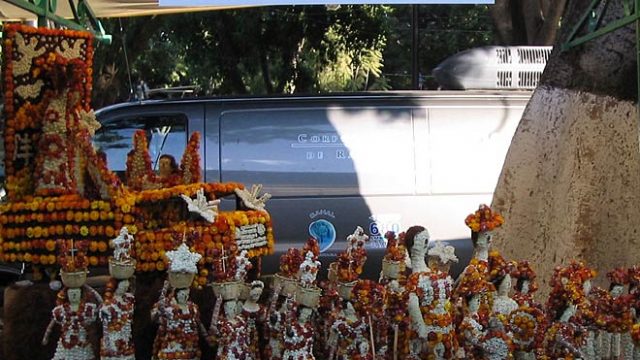Carve the radish, Oaxaca, Mexico
Known as the Night of the Radishes, the radish carving contest is held on December 23, every year. It is said that nearly a century ago, farmers would carve the radishes to attract potential buyers to the vegetable market before and after Christmas services. In 1897, the town’s mayor turned it into an annual festival. The radishes used in the festival are large (can be up to 3kgs). The artists use the red skin and the white flesh (sometimes adding other fruits and vegetables) in various ways to carve out nativity scenes, Mayan design, wildlife, etc. The carved radishes are then exhibited along the town plaza. The winner receives a monetary prize.
Hurl the oranges, Ivrea, Italy
Called the Battle of the Oranges, it is held in the city of Ivrea in the Turin province. People bombard each other with the juicy oranges brought in from Sicily. According to the legends, sometime in the 12th century, a local miller’s daughter beheaded the town’s evil lord and freed the town from his tyranny. The oranges represented the evil lord’s head and were tossed around. The hurling of oranges became popular since the 1930s, when young girls would throw oranges at the young men participating in the Ivrea Carnival parade. Now, anybody can participate as part of the nine teams on foot or as a member of the carriage crew. Each team has its own uniforms and have to adhere to a set of rules. It is usually held in February (for three days preceding Mardi Gras).

Reach for the dahi handi, Mumbai, India
This popular Indian festival may not be a food fight per se but is based around it. It is held on the day after Janmastami (the birthday of Lord Krishna. The best place to see it is Mumbai and its neighbouring towns. According to religious texts, young Krishna was very fond of churned milk and would often steal it – he would make a human pyramid with the help of his friends and break the pot that his mother would hang from the ceiling to share the contents with his friends. Today, in various neighbourhoods, an earthen pot (handi) containing curd, sweets, money etc. would be hung from a rope whose free ends are tied to two buildings. Young men build human pyramids to reach the pot, break it and get the goodies. In Mumbai and Thane, the simple ritual has now turned into a stiff competition with the height of the rope being extended and lots of cash prizes being awarded to those who can make the tallest pyramid and reach the handi the fastest. A Spanish group from Catalonia, Spain, has been participating in a Thane-based contest for the past few years. The festival is usually held in August-September (to be held on September 6, 2015).
Run after the cheese, Cooper’s Hill, Gloucestershire, United Kingdom
Contestants are strongly reminded that the contest Cheese Rolling in Gloucestershire, is a dangerous activity and they have to attend at their own risk. But still participants arrive to follow the cheese that rolls down the slopes of Cooper’s Hill. In the process, they tumble and roll (accidents are not unheard of) but rarely give up. The winner gets to keep the cheese, a Double Gloucester Cheese, weighing 7-8lb. According to the contest’s official website, the cheese is made by Mrs Diana Smart, the only person in Gloucestershire making a Double Gloucester Cheese by hand using traditional methods.

Throw the knobs, Dorset, United Kingdom
To know how far you can throw the biscuits, you have to be in Dorset’s knob throwing competition. The participants have to throw the knobs, locally made spherical biscuits, with an underarm motion. Held annually since 2008, it also includes other contests such as knob-eating, knob darts, knob-a-thon, knob walking, knob archery, pin the knob, etc. Dave Phillips’ throw of 29.4m (96ft) in 2012 is yet to be surpassed. The winners receive their winning biscuit (made by the Moores family since 1860 and the only manufacturers now) and a plaque; their names are also added to a board in the village hall. A food festival is also held to complement the contest. In 2015, it was held in May.

Toss the pudding, Yorkshire, United Kingdom
On the annually held Yorkshire Day (August 1), you will be allowed to toss the famous Yorkshire pudding as part of the celebrations. The winner with the biggest throw will be dubbed the Yorkshire pudding throwing champion and receive a crown made from pudding.




